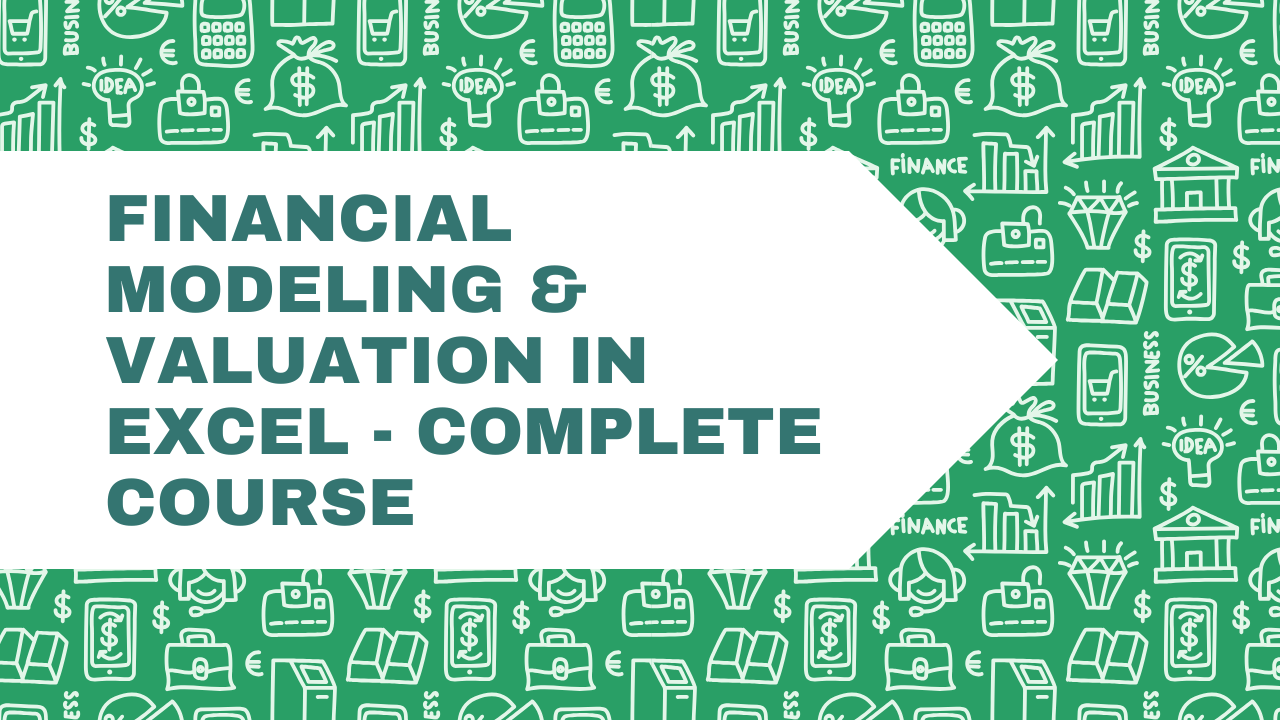This comprehensive course offers a deep dive into financial modeling, equipping learners with essential skills in Excel, accounting, and valuation strategies. Beginning with a meticulous exploration of MS Excel basics, the course progresses to advanced features and functions, ensuring a robust foundation for financial modeling.
The Excel training covers everything from cell formatting to complex formulas, conditional formatting, and data analysis techniques.
The Accounting Foundation section demystifies financial statements, business cycles, and various accounting principles, preparing students for the intricacies of financial modeling.
Moving forward, the course delves into the specifics of Income Statements, offering insights into formats, profit margins, and revenue recognition methods. The Balance Sheet section provides a comprehensive understanding of assets, liabilities, equity, and valuation methods.
The Cash Flows Analysis segment clarifies the nuances of cash flow statements, utilizing both direct and indirect methods, and includes a detailed walkthrough of a comprehensive example.
The Valuation section demystifies concepts like DCF (Discounted Cash Flow) and Relative Valuation, exploring dividend discount models, cash flow forecasting, and sensitivity analysis.
The course reaches its pinnacle with a hands-on Financial Modeling of Apple Inc., guiding learners through revenue forecasting, cost sheet calculations, balance sheet components, and a step-by-step walkthrough of the DCF mechanics. The section concludes with sensitivity analysis, growth rate considerations, and exit options, providing a holistic view of financial modeling in a real-world context.
Whether you’re a finance professional, aspiring analyst, or anyone seeking mastery in financial modeling, this course offers a structured and comprehensive journey from fundamentals to advanced techniques. With its practical approach and real-world examples, it’s an invaluable resource for building expertise in the realm of financial modeling.
Section 1: Course Overview Lecture 1 introduces the course, providing a glimpse into the extensive coverage of financial modeling, Excel skills, and accounting principles.
Section 2: Basic Excel Training for Financial Modeling Lectures 2-43 take learners through a comprehensive Excel training journey. Starting from the basics of accessing MS Excel to advanced topics like conditional formatting, tables, and PivotTables, this section ensures a solid foundation in spreadsheet skills.
Section 3: Advanced Excel Features & Functions for Financial Modeling Lectures 44-101 delve into advanced Excel features and functions crucial for financial modeling. Topics include logical functions, date functions, text manipulation, data validation, and a range of tools for data analysis and visualization.
Section 4: Accounting Foundation Lectures 102-125 provide an introduction to financial accounting, covering the purpose of financial statements, income statement accounting, and balance sheet components. Learners gain insights into reading annual reports and investigating non-recurring charges.
Section 5: Understanding Income Statement for Financial Modeling Lectures 126-163 focus on income statement concepts, revenue recognition methods, and a detailed exploration of Colgate’s income statement. The section includes hands-on exercises to calculate profit margins and analyze changes in accounting estimates.
Section 6: Understanding Balance Sheet Lectures 164-161 cover balance sheet essentials, including current assets, long-term assets, liabilities, and shareholder’s equity. Learners gain practical experience in valuing inventory, handling prepaid expenses, and understanding goodwill and other comprehensive income.
Section 7: Cash Flows Analysis Lectures 165-177 provide a comprehensive understanding of cash flows, covering direct and indirect methods, CFO, CFI, and CFF. The section includes detailed examples and exercises to calculate comprehensive cash flow components.
Section 8: Valuation, DCF & Relative Valuation Lectures 178-211 delve into corporate valuations, DCF models, and relative valuation methods. Topics include dividend discount models, forecasting income statements, and calculating enterprise value. Learners gain expertise in sensitivity analysis, understanding options, and calculating cost of debt and equity.
Section 9: Financial Modeling of Apple Inc. Lectures 214-257 offer a hands-on financial modeling experience with a focus on Apple Inc. Learners go through revenue forecasting, cost sheet calculations, cash flow projections, and DCF valuation. The section concludes with sensitivity analysis, growth rate considerations, and exit options.
This course provides a structured and comprehensive learning path for individuals seeking proficiency in financial modeling, Excel, and accounting, ensuring practical application through real-world examples and exercises.
Financial modeling is a technique used by companies for financial analysis in which the income statement, balance sheet, and cash flow statement of a company are forecasted for the next five to ten years. It includes preparing detailed company-specific excel models which are then used for the purpose of decision-making and performing financial analysis. It is nothing but constructing a financial representation of some, or all, aspects of the firm or given security. In other words, It is preparing the expected financial statements predicting the company’s financial performance in a future period using the assumptions and historical performance information. One may use such financial models in DCF valuations, mergers and acquisitions, private equity, project finance, etc.
This course is a comprehensive bundle of MS Excel, Valuation, Accounting, Financial Analysis and Financial Modeling. Any one interested in a career in Finance and Financial Analyst Industry. This course is a must. Many students and professionals assume that their chances of making an Analyst career in Finance Industry are bleak if they are not from the top tier colleges. However, we have seen industry trends where skilled students and professionals from lesser known universities and companies making into big financial firms and organizations. Universities are very limited in their curriculum as they are mostly restricted to focus on theoretical aspects than actual practical know-how. Financial Analyst Training involves analyzing companies’ financials in detailed manner. Analysis is conducted through a composite of financial records, news and interviews with company insiders. It is also known as securities research or Fundamental Analysis. It consist of the sell side research i.e. when research done by analyst are provided to their clients and also buy side research i.e. when analyst do research and use it to invest their firm’s money. The work within Financial Analysis mainly revolves around Financial Modeling Techniques, forecasting, valuations like DCF and Relative Valuations (estimate growth rate and valuations for companies in future).

10,000+ unique online course list designs